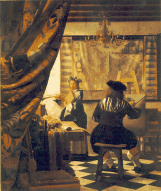The Allegory of Painting
Vienna, Kunsthistorisches Museum
120x100 1666-67
 (Large)
(Large)
This painting is not a tranquil interior, charged with mood. This painting
is a host of symbols and icons. A curtain covers much of the canvas,
indicating that this is a stage-set, and the diagonal pattern of floor
tiles draws the eye into the scene. There is a chair at lower left,
ready for the viewer to sit down and watch the show.
The combination of the horizontal roof beams and strong horizontals
from the map lend stability to the composition.
The woman has a blue dress and a
yellow skirt, she has a crown of laurel, a trombone, and a book; she
is interpreted as Clio, the muse of History, as described by Cesare Ripa's
Iconologia, an Italian study of symbols that was translated into
Dutch in 1644. The book she holds is the works
of Thucydides, the Classical Greek historian. The name for this painting is
therefore wrong: it is not about painting, but about history.
The chandelier hanging from the ceiling has a double-headed eagle motif
at the top, symbolic of the Habsburg empire, who had recently been ejected
from the newly-democratic United Netherlands. There are no candles in the
chandelier, showing Vermeer's opinion of the power of the Habsburgs.
A large part of the canvas is taken up by a map of the Netherlands,
produced by Nicolaes Visscher, from 1592, when the Habsburgs still
occupied the Netherlands. The map is, however, divided by a prominent
vertical crease into the newly liberated United Netherlands (right),
and the remaining occupied Spanish part:
Catholic Flanders, that will eventually become Belgium.
The margins of the map have scenes of cities, and The Muse of History stands
directly in front of the view of The Hague, the seat of the Dutch Court
and residence of the House of Orange.
The painter, dressed in fanciful, not contemporary, clothing, works with
an almost empty canvas, symbolic of the new republic of the United Netherlands.
Furthermore, the easel on which he paints is directly in front of the
new country.
On the table at the left, silk flows towards us, echoing the flow of light
from behind the curtain. Also there is an object that looks like an
oversize death-mask, which may be the face of Willem I, from the
tomb of the House of Orange in the Prinsenhof in Delft.
This picture was sold to the Nazi art advisor, Hans Posse, in 1940, who
was buying on behalf of Hitler. It was stored in a salt mine near Vienna
for five years, and in spite of the efforts of the liberating Americans
to acquire it, was eventually transferred to the Kunsthistorisches Museum
in Vienna in 1946.
Brought to you by
BallAndClaw.com.
 (Large)
(Large)